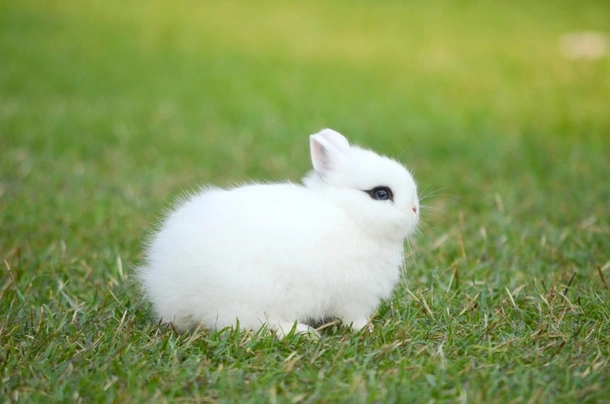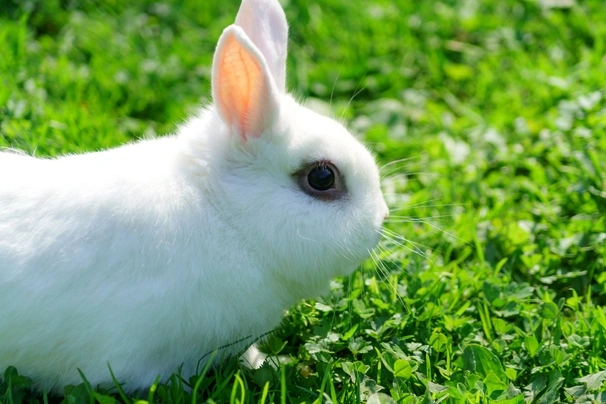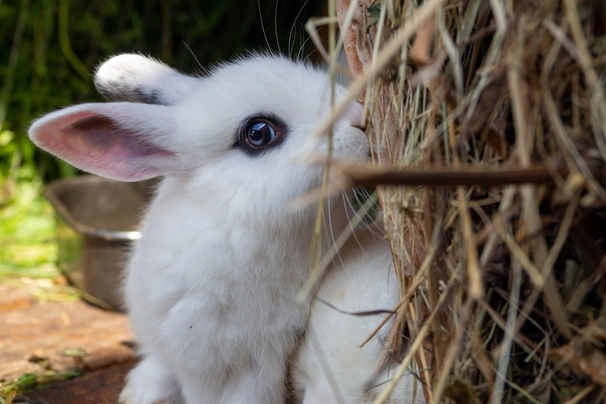Pets
Pets for studWanted petsBreedersAccessories & services
Knowledge hub
Support
Support & safety portalDwarf Hotot
Introduction of the Dwarf Hotot
This breed is one of the latest to be recognised by the American Rabbit Breeders Association, having only achieved registration in 1984. The Dwarf Hotot is characterised by an entirely white coat with circles of either black or chocolate around each eye.
While the much larger Blanc De Hotot was developed in the early 19th Century as a meat and fur animal, the story of the diminutive Dwarf Hotot is a little bit more interesting.
History of the Dwarf Hotot
The original Hotot breed – the large Blanc de Hotot - was founded in the early 19th Century as a meat and fur animal. The distinctive coloured circles around the eyes were bred into the Hotot in order to make it attractive to those buying furs. As time wore on, and tastes changed the bigger, commercially viable rabbits were passed over in favour of the smaller dwarf breeds, which means that those who were interested in developing new breeds, could concentrate on breeding for a smaller animal knowing they could still make a profit.
In the 1970s, two breeders began working on developing a Dwarf Hotot. These breeders were working completely independently of one another; one in East Germany and one in West Germany. One of the breeders put a Netherland Dwarf to a large Blanc de Hotot, while the other didn’t use a Hotot at all. This breeder put a black Netherland Dwarf to a Dutch and bred out all markings until only the eye bands were left. These two versions of the Dwarf Hotot were eventually brought together and created the breed as we know it today.
Appearance of the Dwarf Hotot
- Main colourways: white coat with chocolate or black bands around the eyes
- Average weight: 1 – 1.5kg
The Dwarf Hotot is a small, ‘cobby’, compact rabbit that has a rounded head with a wide skull at the end of a barely visible neck. It’s stocky and quiet – very much like a Netherland Dwarf. The eyes must be bright and bold and the ears are short, furry and with good ‘substance’. They should be in balance with the head and the rest of the body.
The Dwarf Hotot’s body should be symmetrically wide from hips to shoulder with a well-rounded rear end. The topline must have a very slight curve from the bottom of the ears to the highest point above the hips; falling away smoothly to the bottom of the tail.
The coat of the Dwarf Hotot is short, thick, fine and soft with an obvious lustre. The fur should roll back quickly into position when stroked the wrong way. The rabbit should be the purest white in colour with the only colour being the narrow bands around the eyes. The eyes themselves should be dark brown. It’s said the ideal eye band width should be equal to the width of two pennies.
Temperament of the Dwarf Hotot
The Dwarf Hotot makes a lovely pet as it’s a gentle, clever and playful little rabbit. They are affectionate if they are allowed to get used to human company from a young age and will love to play with simple toys. Many fanciers and rabbit owners find the smaller breeds much more practical to own and show as they require less living space and also cost less in terms of food too.
Because these are docile rabbits they are generally good with children and often display quite distinctive personalities. Many enjoy being held and petted, while others like to sit close to their owners, hopping on and off their lap. The Dwarf Hotot does tend to enjoy affection though and will happily return that affection.
They are able to keep themselves entertained for most of the day – particularly if they have access to simple toys. A ping pong ball or cardboard tube will be very much appreciated. They are relatively easy to train and will appreciate being carried around and cuddled.
Health of the Dwarf Hotot
Rabbits are quite delicate creatures and as such can succumb to a number of conditions, however the good news is that many of the worst conditions, such as flystrike, myxomatosis and dental problems, can be easily prevented.
Pet and show rabbits should be given treatment for worms, ticks and fleas and it’s also recommended that they are vaccinated against myxomatosis and Viral Haemorrhagic Disease – both nasty conditions that can be fatal. Non-breeding female animals can be spayed in order to prevent uterine cancer and your pet must also be monitored closely to make sure he’s grooming himself thoroughly. If he’s still a bit dirty, it might be because his weight is stopping him from cleaning himself properly. Any dirty areas of his coat must be cleaned and his weight should also be controlled or flystrike could become an issue – particularly in warmer weather when flies are prevalent.
The teeth of all rabbits should be checked frequently as they grow constantly and can quickly overgrow and cause problems in the mouth unless they are kept worn down by a diet that’s high in roughage.
Caring for the Dwarf Hotot
It’s crucial that you decide where your rabbit’s going to live before you bring him home. If you’re going to allow him to live indoors please consider that this is a small, delicate animal that can move quickly. All residents and visitors must be careful to avoid stepping on the rabbit or equally, being startled by a fast-moving creature.
All of your important belongings should be moved out of the way or he may be tempted to chew them. This includes shoes, books, toys, wires and cables. In order to fulfil his desire to gnaw, he should be given items he can chew. Gnaw toys, branches and cardboard boxes and tubes are all excellent items for him to chomp on. An intelligent animal like the Dwarf Hotot can be trained to use a litter tray quite easily and he must be offered a quiet place to relax– a dog crate is ideal.
As a playful rabbit, the Dwarf Hotot will need regular access to outdoor space, either in a run or in a secure area of garden. If your rabbit’s going to be living in a hutch it should be completely weatherproof but airy, with a secure mesh front which must be fine enough to prevent small feet poking through and getting stuck.
The hutch must be large enough for him to hop from one end to the other and stand on his hind legs and must also be placed in a sheltered spot – a large shed is perfect. Any living area must be cleaned out once a week and soiled areas should be removed each day.
In order to keep his teeth worn down and his weight under control he should be fed high quality hay and he should also be given lots of fibrous vegetables such as nettles, kale, cabbage and dandelion leaves. He must have unlimited access to fresh, clean drinking water.


